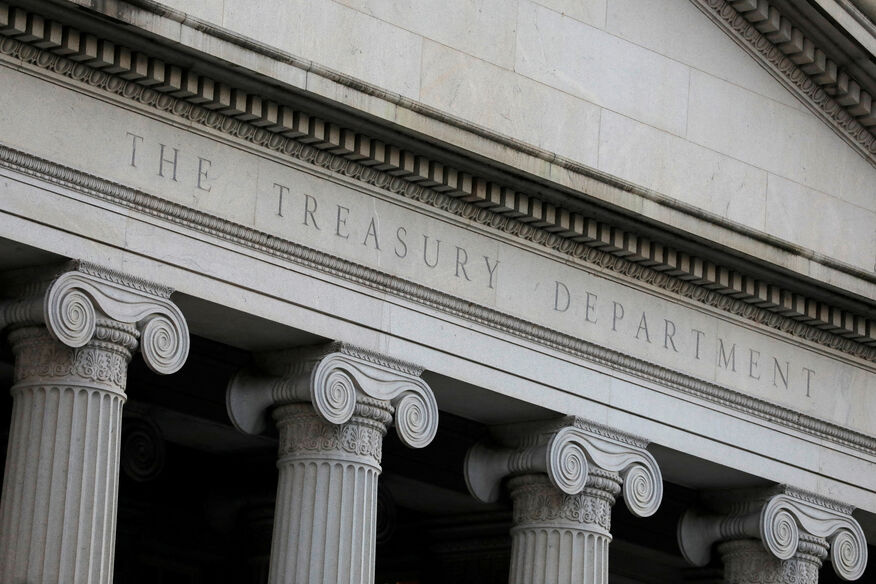[Reuters Analysis] Trump's push for regulatory reform highlights ‘Treasury put’: Jen


By Stephen Jen
LONDON, July 1 (Reuters) - There has been much discussion of the so-called "Trump put" for equities, but perhaps more attention should be paid to the administration's effective "Treasury Put".
Given the high U.S. public debt burden, the government must keep interest rates under control, and that appears to be the primary motivation for the Trump administration's recent push to relax a key bank regulatory requirement.
U.S. Treasury Secretary Scott Bessent on May 27 discussed progress made to relax the Supplementary Leverage Ratio (SLR) requirement for U.S. banks.
The SLR was introduced in early 2018 as part of the Basel III bank regulations to help ensure large banks held sufficient capital. The SLR is a second layer on top of the normal capital requirement, which is why it is considered "supplementary".
What is special about the SLR is that banks' holdings of Treasuries incur a capital charge, in contrast to the normal capital requirement, which assigns government bonds a zero-weighting for risk purposes.
Based on the current SLR, large banks in the U.S. are charged a 5% capital fee, while smaller banks are charged 3%.
NECESSARY REFORM
It is widely accepted that the SLR needs to be relaxed because it appears to be hurting large banks' ability and capacity to provide market liquidity, a particular concern given how much Treasury issuance has exploded since the pandemic.
Outstanding U.S. Treasuries, including those held by the Federal Reserve, rose from 100% of GDP prior to 2020 to around 120% now, exacerbating the disconnect between supply and demand.
Fed Chair Jay Powell has weighed in, commenting in February 2025, "The amount of Treasuries has grown much faster than the intermediation capacity has grown, and one obvious thing to do is to lower the bindingness of (the SLR)."
The Trump administration is supporting efforts to do just that, with an agreement to relax the SLR expected this summer.
COST CONTROL
Even though SLR reform is intended to improve liquidity and thereby support bank lending and economic growth, one of the Trump administration's other key motivations is clearly keeping a lid on government borrowing costs.
Treasury Secretary Bessent indicated as much in his May 27 interview, stating that relaxing the SLR could "bring yields down by tens of basis points."
With the caveat that it is very difficult to estimate the yield impact of SLR reform econometrically, there's reason to believe that Secretary Bessent could be right.
Reducing the SLR should, in theory, lower yields by boosting bank demand for Treasuries. Market estimates suggest that a one percentage point SLR reduction could lower the 10-year Treasury yield by 10-50 basis points, depending on the circumstances.
Based on this estimate, dropping the SLR charge by two percentage points – a likely reform – could double that. Based on that assumption, we would expect to see a 0.50 percentage point reduction in the 10-year yield, which is consistent with Secretary Bessent's statement of "a few tenths of a percent".
'BOND PUT'
The Trump administration is keeping a close eye on the bond market. Secretary Bessent has long been clear that getting the U.S. fiscal deficit under control is one of his top priorities, but this will be difficult to achieve if interest rates are too high relative to economic growth.
The Secretary's repeated references to a relatively obscure issue like SLR relaxation and its potential impact on Treasury yields only highlights this focus.
Importantly, this is not just a matter of watching out for bond market ructions, which any administration would do. It's about taking action to try to keep yields down.
In other words, there is more likely to be a Trump "bond put" rather than a Trump "equity put". Or to put it another way, the strike price on the former is likely to be a lot higher.
LOOKING FORWARD
Given the Trump administration's focus on the bond market and recent trends in U.S. inflation and economic activity, it is reasonable to assume that the 10-year U.S. Treasury yield could trade below 4.00% in the fourth quarter, down from its current level around 4.30%.
While yields remain elevated, likely because of perceived fiscal risks, a prospective relaxation of the SLR could have the opposite effect by boosting demand for U.S. government bonds.
To be sure, other economic, geopolitical or market factors could complicate this scenario.
But if we do see lower bond yields, this should support risk assets and be negative for the dollar, and, perhaps most importantly, it may buy more time for the U.S. to deal with its fiscal challenges.
(The views expressed here are those of Stephen Jen, the CEO and co-CIO of Eurizon SLJ asset management).
Enjoying this column? Check out Reuters Open Interest (ROI), your essential new source for global financial commentary. ROI delivers thought-provoking, data-driven analysis of everything from swap rates to soybeans. Markets are moving faster than ever. ROI can help you keep up. Follow ROI on LinkedIn and X.
Interest on U.S. debt is piling up

Growing Treasury Market

US 10-year Treasury yield








